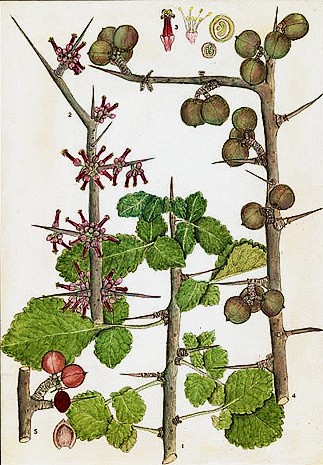Lessico
Bdellio

Dal greco bdéllion,
che indica una pianta e la sua gomma
aromatica, ed è
voce d'origine semitica. Gommoresina che si presenta sotto forma di grosse
lacrime sferoidali, rossastre o rosso-brune, dall’odore aromatico che
ricorda la mirra![]() (prodotta
per lo più dalla Commiphora myrrha), dal sapore molto amaro. Si ricava
da varie specie del genere Commiphora, Burseracee africane e asiatiche,
per lo più dalla Commiphora africana. Lo bdellio si usa in profumeria
e in medicina come amaro, tonico e astringente.
(prodotta
per lo più dalla Commiphora myrrha), dal sapore molto amaro. Si ricava
da varie specie del genere Commiphora, Burseracee africane e asiatiche,
per lo più dalla Commiphora africana. Lo bdellio si usa in profumeria
e in medicina come amaro, tonico e astringente.
Commiphora
Commiphora is a genus of flowering plants, family Burseraceae. It includes about 185 species of trees and shrubs, often armed or thorny, native to Africa, Arabia, and the Indian subcontinent. Several of these species produce fragrant resins used for incense, perfume, and medication, including Myrrh (Commiphora myrrha) and Balsam of Mecca (Commiphora opobalsamum).
Selected species
Commiphora africana
(syn. Heudelotia africana), sometimes identified with ancient bdellium.
Commiphora angolensis, also known as "sand commiphora",
growing mainly in Angola and Namibia.
Commiphora boranensis
Commiphora caudata
Commiphora corrugata
Commiphora gileadensis (syn. Commiphora opobalsamum), producing balsam of Mecca.
Commiphora habessinica
Commiphora humbertii
Commiphora kataf (syn. Commiphora
erythraea), producing bisabol.
Commiphora madagascariensis
Commiphora mossambicensis
Commiphora myrrha (syn. Commiphora molmol), producing myrrh.
Commiphora schimperi
Commiphora
stocksiana, known
in Pakistan as bayisa gugal
Commiphora wightii (syn. Commiphora mukul),
producing gum guggul, sometimes identified with ancient bdellium.
Bdellium
Bdellium: middle English, from Latin, from Greek bdellion, variant of bdolkhon, of Semitic origin; akin to Akkadian budulhu. Bdellium (Hebrew bedolach) was an aromatic gum like myrrh that was exuded from a tree. It has been identified with the species Commiphora wightii, now called guggul, although bdellium was also used for the African species Commiphora africana, family Burseraceae, and at least one other Indian species, Commiphora stocksiana. Bdellium was an adulterant of the more costly myrrh (Commiphora myrrha); guggul is still used as a binder in perfumes.
The word occurs only twice in the Hebrew Bible. The first is in Genesis 2:12, where it is described as a product of the land of Havilah; the context has led some readers to link bedolach with pearls or other precious stones. Bdellium is mentioned once again, as something familiar, in Numbers 11:7, where manna is compared to it in color: "Now the manna was like zera gad [coriander seed], and its appearance as the appearance of bedolach."
Bdellium appears in a number of ancient sources. In Akkadian, it was known as budulhu. Theophrastus is the first classical author to mention it, and Plautus the second in his play Curculio. Pliny the Elder describes it as a "tree black in colour, and the size of the olive; its leaf resembles that of the oak and its fruit the wild fig" (N.H. 12.19). It was an ingredient in the prescriptions of ancient physicians from Galen to Paul of Aegina, and in the Greater Kuphi.